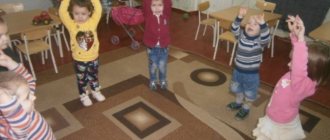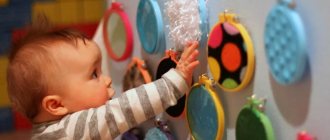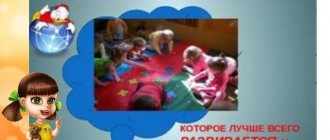Corner of sensorimotor development in preschool educational institutions
All-Russian permanent PROFESSIONAL competition for teachers of preschool educational institutions “Developmental environment in preschool educational institutions”-2021
Savelyeva Irina Valerievna
teacher
MBDOU D/S No. 27 “Beryozka”
Corner of sensorimotor development in preschool educational institutions
The task of teachers in children's institutions is to organize a play area for children, saturate it with such objects, toys, while playing with which the child develops movements, learns to understand their properties - size, shape, and then color, since correctly selected didactic material and toys attract attention baby to the properties of objects. The harmony of the combination of various shapes, sizes, textures, colors of objects, the natural qualities of natural materials not only allow children to master new sensations, but also create a special emotional mood.
Advertising message
Play is the main form and content of organizing children’s lives; play is the most favorite and natural activity of younger preschoolers; the teacher carries out the sensory development of children through play activities. While playing, a child learns touch, perception and assimilates all sensory standards, learns to compare, compare, establish patterns, make independent decisions, develops and learns about the world. Toys are located in different places in the group room so that children do not gather in large groups and disturb each other. Each type of toys and aids is stored in a certain place: large building materials - on shelves, in drawers, balls - in baskets, doll dishes - in a children's closet, books - on a shelf, large toys for movement - in a specially designated corner of the group, etc. d. Such storage of toys ensures order in the group and helps the child to better navigate. Toys and aids are systematically updated, this increases interest in them and allows them to be used more variably.
The group has created a corner for sensorimotor development of children. The corner is intended:
- to stimulate sensory functions (vision, touch, hearing, smell, etc.);
- development of fine motor skills, stimulation of motor activity;
- relieving muscle and psycho-emotional tension, achieving a state of relaxation and comfortable well-being for children;
- creating a positive emotional background, increasing the child’s performance;
- activation of cognitive processes (thinking, attention, perception, memory);
- increasing motivation for independent and experimental activities of preschool children.
The purpose of the sensory corner in the group is the development of all types of perception, the creation of conditions for the implementation of sensory-perceptual abilities, speech and mental development of children, an emotionally positive attitude towards objects and actions with them.
The sensorimotor corner is used in the pedagogical process, both in organized classes and in children’s independent play activities.
A very important part of the development of sensory abilities is “finger games”.
“Finger games” are the staging of some rhymed stories or fairy tales using the fingers. Funny folk nursery rhymes are passed down from generation to generation: “Ladushki-Ladushki”, “Magpie-white-sided”, “Horned Goat” and other finger games. Many games require the participation of both hands, which allows children to navigate the concepts of “right”, “left”, “up”, “down”. Finger games are exercises to improve finger mobility, develop their strength and flexibility. The more a hand can do, the smarter its owner. The movements alternate between compression, stretching, and relaxation; the distribution of tone in the hand and fingers can be traced.
Games with objects have a beneficial effect on the development of movements of the entire hand and fingers: pyramids, inserts of various types, multi-colored abacus, nesting dolls, mosaics, games with pencils, finger pools with various fillers, lacing games, games with clothespins, etc.
Based on the use of sensory games and exercises for the development of tactile and visual perception, preschoolers develop observation, attention, memory, imagination, organize the impressions they received when interacting with the outside world, expand their vocabulary, acquire gaming, educational and experimental skills. search activity.
What is a sensory room for children and what is it for?
From the point of view of pedagogy, as a science, the sensory room in kindergarten is still at an experimental level. However, despite this, this tool has already established itself as a truly effective and absolutely safe means for education and development. Regardless of whether we are talking about individual or group sessions, the sensory room shows truly amazing results.
The same applies to children who have the following problems:
- Closedness, low level of attention, as well as motivation to learn. After just a few lessons, the child shows a much more active interest not only in learning, but also in communicating with other children and teachers. All this happens due to the activation of the emotional background during work.
- Attention deficit disorder and hyperreactivity. While inside the sensory room, such children begin to behave more restrained. This helps them focus more on attention and, therefore, absorb knowledge more easily and effectively. In addition, the sensory room also promotes relaxation, not only physically, but also emotionally.
- Children with autism. Using the sensory room, these children literally before our eyes begin to find a common language with teachers, as well as peers. Without withdrawing into themselves, they acquire all the skills necessary for development and learning.
Thus, sensory rooms for young and middle-aged children provide comprehensive correction of not only psychological, but also various types of physical disorders.
You need to understand that all classes are conducted exclusively in a playful form. It has been proven by scientists and teachers that this is the way children learn information best. In addition, relaxation is used to stimulate a certain feeling or quality, thanks to which preschool children develop their physical as well as sensory skills without much effort. This is a very important point that will help the child in the future, since it will be much easier and simpler for them to concentrate on certain things, find a common language with people (socialization), clearly define their life position and position, being able to defend it in front of others, etc.
What safety features are needed to use the sensory room?
The main condition for training is safety. Sensory rooms, or rather their contents, should pose absolutely no threat to both the physical and psychological health of children. To do this, the elements must fully comply with all hygiene standards and not be toxic.
We are talking about preschoolers, that is, small children, therefore, there should not be any sharp corners that the child could get hurt on. For this reason, it is best to use frameless furniture with soft fillings. This includes rugs, ottomans, play blocks (transformable houses, floor constructors) and others.
Speaking of small elements, they should all be secured as securely as possible to the main structures, since otherwise kids can easily swallow them with the corresponding consequences.
Without exception, all materials that are present in the sensory room must be made of easily washable materials. Rugs and other fleecy elements must be treated with special compounds. Such products not only remove dirt, but also disinfect the surface, but do not contain chemicals and are completely safe for children. In addition, they should not emit any odors at all, including pleasant ones.
When using children's sensory rooms, special attention should be paid to electrical and electronic devices. Each such device must have maximum resistance to high humidity. All switches and especially sockets are located in such a way that a child cannot reach them.
As you can see, sensory rooms for kindergarten are truly a modern teaching tool, which, if handled correctly and with pedagogical knowledge, can really solve many issues, including quite serious ones.
With the help of sensory rooms, children suffering from psychological, emotional and physical disorders will be able to solve all their problems. Very soon your baby will experience all the joys of learning about the world, and you will experience joy and pride in your son or daughter.
Everything you need to equip a sensory room.
How is the learning process organized?
Based on the emotional, physiological or psychological needs of preschool children, classes are divided into two forms: individual and group. From the point of view of psychological and pedagogical impact, the following areas are usually distinguished:
- Neuropsychological correction. It is used most often for children who lack the motivation to remember and assimilate new information, including knowledge of the world around them.
- Correction and psychocorrection of behavior. As practice shows, it is best used for children who experience frequent outbursts of anger, as well as isolation and lack of self-confidence. In addition, such classes show excellent results if it is necessary to remove the baby from a hyperactive or, conversely, passive state. Based on the specific problem, calming or stimulating measures are used. As a result, the child learns to cope with the control of his own emotions, find a common language with others, and also get rid of obsessive states.
- Correction of neurological problems and psychotherapy. Classes of this kind are especially effective when a child stutters, feels fears, and also experiences neuropsychiatric and mental disorders. Such training is usually carried out either individually or in groups of 2-3 children.
- Development classes. Most often used for children aged 1-3 years. They can also be used for older children, especially if they have problems with attention, memory, speech, imagination or imaginative thinking. As a result of this training, children learn to remember various information and also significantly expand their vocabulary.
Speaking about older groups in kindergartens, sensory rooms are often used for them as an effective tool in preparing for school. To do this, children develop skills for independent thinking, resistance to stress, motivation to study and other important aspects.
Corner of sensory development in the first junior group
Olga Martseva
Corner of sensory development in the first junior group
The main task of early development of a child at 2-3 years old is the development of sensory , fine motor skills and coordination of movements. A good helper in the development of fine motor skills in our group are various educational toys that we made ourselves.
I designed a corner (tables)
for sensory development .
First table . On this table is the book " Development "
Second table.
Also here is the “Didactic Skirt”, lacing,
All the games that are in the sensory corner are described in the materials in my block:
— Sensory development in children of the first junior group (do-it-yourself didactic games)
;
— Educational tablet for children “Geometric”
;
— Lesson summary “Didactic skirt”
in
the first junior group ;
— Master class on making the book “ Development ”
for children
of the first junior group (2–3 years old)
Game for the development of fine motor skills “Octopus” Games and toys for the development of fine motor skills contribute to the work of the speech and thinking centers of the brain, the development of creative abilities. Sensory development in children in the first junior group (do-it-yourself didactic games) The main task of the early development of a child at 2-3 years old is the development of sensory, fine motor skills and coordination of movements. A good helper.
Source


